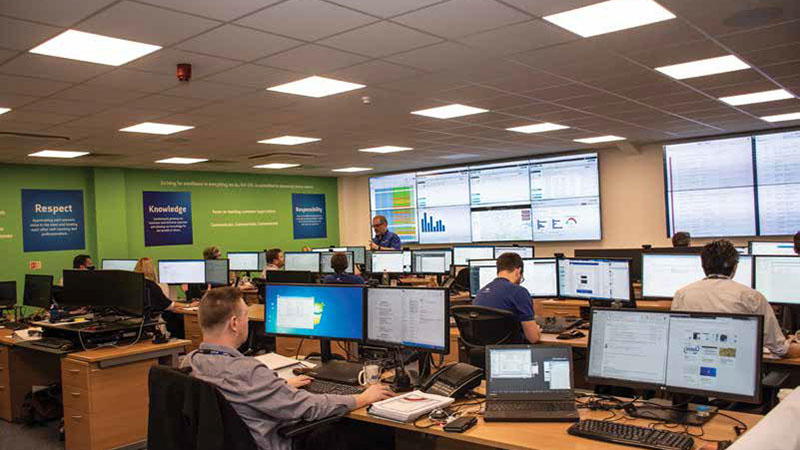
With tech managers increasingly under pressure to contribute to business outcomes, the need for meaningful information on how their AV deployments are performing is paramount. To address this, audiovisual systems monitoring and management technology has moved beyond signaling when systems are down, or when they’re about to fail. These days, systems analytics is getting more granular, and even those manufacturers that aren’t considered developers of monitoring and management tech are integrating at least some kind of analytics capabilities into their offerings.
“Everybody from service providers to manufacturers—even display manufacturers—are now selling analytics capabilities within their toolsets,” said Brian Fichter, vice president of video operations at Carousel Industries, an AV/IT design, integration, and managed services provider headquartered in Exeter, RI. “Support and proactive reach down to the device level in audiovisual is key to being proactive instead of reactive when supporting these systems.”

As is the case with many business functions, AV monitoring and management has moved to the cloud, enabling those organizations who no longer need or wish to maintain on-premise solutions to streamline their efforts in this area. Last year, Crestron Electronics, headquartered in Rockleigh, NJ, introduced its XiO Cloud platform to address the demand for cloud-based deployment, management, and monitoring, and technology manager for enterprise software Brian Donlan noted that solutions like these enable tech managers to spend little to no time worrying about server maintenance and patching; rather, they can narrow their focus to what’s happening with their AV systems.
Donlan also points out that (seemingly) disparate AV devices are starting to be managed on, as he puts it, “a single pane of glass, instead of two things in the room being managed through this one [system], and three other things in the room being managed and monitored through this other thing, and they’re all talking different languages—and all of these different tools have to be handled separately,” he illustrated. Tech managers, unsurprisingly, want this to happen in one location only, and developers are responding.
There has also been a shift toward what Donlan terms “out-of-the-box monitoring and management,” whereby the need for custom programming post-installation is significantly reduced. He said that this helps organizations avoid the dreaded scenario in which, a year after an AV deployment, the person in charge of collecting monitoring and management metrics realizes that the system hasn’t been configured correctly, and that vital information doesn’t exist. “With a shift to systems that are just doing that automatically, that are just gathering everything—because storage is cheaper these days and things can go up into the cloud—it makes that situation a lot less likely to occur,” he said.
But it’s one thing to know that the data is going to be there when you need it; it’s quite another to determine what metrics will actually assist you in making better purchasing and deployment decisions. To attack this challenge, Donlan urges tech managers to ask themselves: what problems are we trying to solve with our AV monitoring and management technology? “Because there’s a lot there, and every conversation that I have with people about what monitoring and management means to them can go in a different direction,” he said. Some organizations define this in helpdesk terms: information is being fed from rooms, live, back to the helpdesk to enable support staff to service end users in real time. Others want to know what equipment has failed (or is going to fail) so that they may respond as soon as possible. And then there are the organizations that may wish to delve deeper into usage statistics in order to shape future purchasing decisions. “Different platforms are going to support different combinations of those things differently—there are strengths and weaknesses across different sets of technology. It’s very important to start at the beginning [and] look at what, specifically, monitoring and management means to them.”
AVI-SPL, an AV design, integration, and managed services company headquartered in Tampa, FL, offers the Symphony Managed Services Platform, its own proprietary monitoring, management, and analytics solution. Tim Riek, senior vice president of service operations at the firm, noted that AVI-SPL is establishing an as-a-service model for Symphony, similar to other cloud offerings that tech managers are accustomed to. (Symphony is also available as an on-premise solution.) “I would encourage tech managers to take a look at the different consumption models that are available, depending on what their preference is,” he said. “There are new consumption models coming available [that are tailored] to how [tech managers] handle ongoing support.”

As AV monitoring and management continues to evolve, Donlan predicted that these systems will increase their application of AI to identify patterns that may not be readily apparent to human beings. He uses meeting room scheduling as an example, where a space on a certain side of an office complex may be less in demand during specific hours of the day—not because of technical problems, but because of the building’s siting. “It may not show up directly as much of a pattern if you’re just looking at the information, but the system might be able to identify that this space is on the side of the building where the sun is rising, and you need to put in shades and adjust the heating and cooling to make it comfortable for people to actually meet there,” he illustrated. “It’s able to see these patterns and pull them together so that you can take those actions to make a more comfortable and effective collaboration space.”
Carolyn Heinze is a freelance writer/editor.
Data Deluge
AV monitoring and management systems may be collecting more and more information, forcing tech managers to determine what data is actually useful to them. “[One] thing that we see really frequently is you’ve got traditional AV systems monitoring and management tools deployed but never really optimized or configured to enable beneficial use—they’ve put the software on the server, the server can access the technology, but it gets flooded with non-beneficial information which ultimately leads to it being turned off,” illustrated Tim Riek, senior vice president of service operations at AVI-SPL. Developing a plan for what information is actually useful helps to prevent data overload.
Brian Donlan, technology manager for enterprise software at Crestron, offered this advice: “I always like to look at things as far as the actions that I can take, and then work backward from there,” he said. “What are the inputs that are going to be available in this room? What limitations can be made on who’s booking these spaces? How many rooms can do video calling, versus audio calling, versus just presentation? Identifying where you’re going to be making purchasing decisions, how you’re going to be able to help your users, and then pulling that exact data is the path that you need to take.”